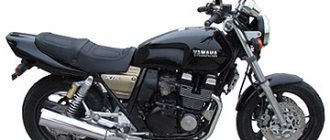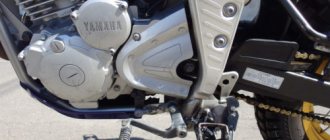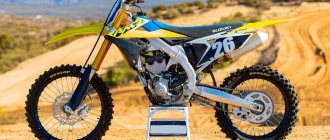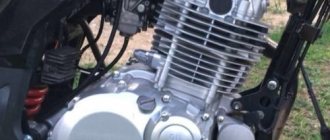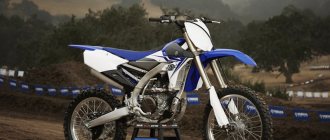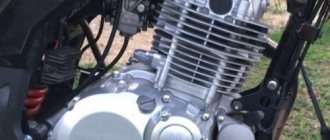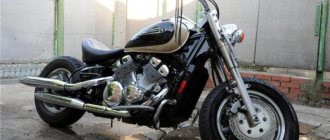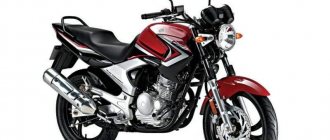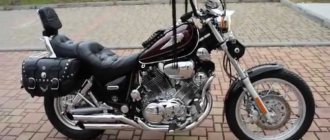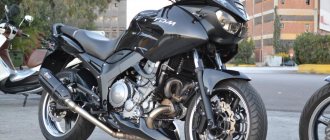| Yamaha SR400 (1978-1984) | Yamaha SR400 (1985-2000) | Yamaha SR400 (2001-2020) |
| Yamaha SR400 Final Edition (2021+) | Yamaha SR400 Final Edition Limited (2021) |
Model of a retro classic motorcycle Yamaha SR400
begins its history in 1978 and is produced to the present day. The main reason for the appearance of this model was Yamaha’s desire to present to the market the simplest retro classic in familiar forms and without any modern technologies that are unacceptable for motorcycles of this class. As a result, the Yamaha SR 400 was born, equipped with a simple 1-cylinder air-cooled engine producing 27 hp. power and 29 Nm of torque. It is also noteworthy that the motorcycle was not equipped with an electric starter, but was started using a traditional kick starter. However, to make starting easier, Yamaha installed a standard decompressor on the left console and an inspection window on the right engine cover, making it easier to find the optimal position of the piston in the cylinder.
The key features of the Yamaha SR400 include a simple steel frame, a dry sump (the oil was in the frame), simple suspension in the form of a telescopic fork at the front and a double shock absorber at the rear, a rear drum brake and 18′ spoked wheels.
The Yamaha SR400 model is rarely used in stock condition and is often the basis for building custom motorcycles - mainly cafe racers. This is why it is difficult to find a fully stock motorcycle. In the Russian Federation, this model is quite rare, but in Japan it is in great demand, so the Yamaha SR400 is presented in large quantities at Japanese auctions. Since 2014, the model has been available in the North American and European markets.
In 2021, Yamaha introduced new versions of the SR400, which will be the last - Yamaha SR400 Final Edition
and
Yamaha SR400 Final Edition Limited
. The models are distinguished by their exclusive style and anniversary nameplates.
The “big brother” of the model is the Yamaha SR500.
The main competitors of the Yamaha SR400 in the class:
- Kawasaki W400
- Honda CL 400 / Honda CB400SS
Return of a Legend
Interestingly, when the company closed production in 2008 (30 years later) due to obsolescence, there were so many people wanting to buy this model that in 2010 it had to be returned to the production line.
The Yamaha SR400 is a legendary motorcycle that has been in demand for many decades.
In 2015 (2 years of downtime were also taken into account), the company noisily celebrated the child’s 35th birthday by releasing a limited batch.
The bike is not very familiar to Russian users (at about the same time we were offered Java), but at world auctions demand still exceeds supply . You rarely see a motorcycle in stock configuration. Many buyers take it as the basis for their own custom bike, mostly to create a cafe racer.
Yamaha SR400 design
The year of production began determined the material.
Front fork with corrugations.
Rear shock absorber with open spring.
Most of the bike's parts, from the frame to the suspension, were made of steel . a duplex scheme was used .
The stock suspension setup is simple - a telescopic fork for the front wheel with a travel of 105 mm and a stay diameter of 35 mm , a pair of shock absorbers on a pendulum for the rear. Their working stroke was longer - 150 mm .
The only nod to modernity was the ability to adjust the preload in the rear . You can set one of five fixed positions.
The highlights of the model are the transparent right engine cover and an additional button for controlling the standard decompressor, located on the left steering wheel. Both were supposed to help start the engine.
Exterior
For many, it is the exterior of this model that is the decisive reason for purchase, because now it is quite difficult to find a “real” motorcycle without unnecessary plastic and wires.
As bikers say, the SR400 is a motorcycle for real men. Everything is iron, except for two decorative triangular trims on the sides between the rear wheel and the engine.
A characteristic feature of the exterior is the abundance of chrome
Chrome plated shock absorber springs.
Chrome plated brake foot.
Chromed passenger handle.
Chromed gas tank cap.
Front end
For a user who has at least once seen domestic Java, the front panel does not raise any questions.
Within the framework of retro classics, this motorcycle is simply perfect.
- The large fender fits tightly against the 18-inch spoked wheel. The fork stays along it are covered with covers; above, up to the headlight mount, they are covered with corrugated tubes.
- Headlight large, round. The low and high beams are output to different filaments. The instrument panel cups rest on it. There is no windshield, but based on user reviews you can find a original one. DRLs, of course, no.
A classic round headlight and the same classic turn signals on long brackets.
- The turn signals are located on the fork legs, but stick out quite high. An average-sized driver will probably notice if he forgot to turn them off. The steering wheel is slightly tilted towards the motorcyclist, there is no need to stretch . Mirrors on it. Several hinges allow them to be rotated in any direction and adjust the viewing angle to suit the height and build of the owner.
According to user reviews, the motorcycle vibrates at any speed, but this does not interfere with displaying the picture. The mirrors are located not much higher than the ears of passenger cars and a non-impact maneuver can lead to problems with the driver of the car.
Dashboard
This dashboard layout was found on almost all bikes of those years.
The bike does not offer a wide selection of indications, but everything that is necessary for control is here .
- Two cups of dial indicators rest on the headlight , below, between them there is an ignition switch with a shutter.
- On the left is the speedometer . Since the model was offered to all countries, the American version will have markings in mumbles, the European version in kilometers. The marks are 100 or 160, respectively.
- The second cup is a tachometer . It is marked up to 10x1000, red starts from 7.2x1000, maximum power from 7x1000.
- Indicator lamps were not installed separately; they were placed under the windows of the main instruments.
- The speedometer has engine indicators and an indicator that the fuel is running low. There is also a mileage counter in 2 copies - general and current.
Speedometer with a universal scale and indicator lights.
The tachometer has power indicators:
- neutrals;
- high beam;
- turn (one for both).
Back view
General rear view.
Back light.
Double seat.
Fuel tank.
- The curved rear wing forced designers to invent a mount for the brake light and clearance . But the solution turned out to be successful - they can be seen both from the cabin of a tall car and from a bicycle. There, on the wing there is a plate with the number.
- The turn signals are located outside the bike, located at saddle height. It is large and has no separation between passengers . The second number has a slight bend forward along the way. There is a handle behind the seat that he can hold onto while driving. It has folding footrests. There is no trunk, and there is no space for it either. Due to the fact that the rear fender is curved and the stop is placed directly on it, and not under it, there is no possibility to install a pannier .
- The fuel tank is large, holds 12 liters . (including 2.2 l reserve). It is round in shape and has no grooves for the knees. On the top edge there is a lamb with a keyhole inside - the lid of the tank neck. Turn the key, then screw the cap. It is semicircular in shape and problems may arise when using a tank bag.
First trip. 2015 Yamaha SR400 motorcycle
If you are a motorcyclist who was born in the 60s or 70s, then you have probably already ridden a Yamaha SR400.
If not yet, then you have a chance to ride this motorcycle now, because... Yamaha released the new SR400 in 2015. The Yamaha SR400 motorcycle has an air-cooled engine. The outdated carburetor was replaced by an injector, but Yamaha remained true to the retro style and the old school and did not install electric ignition, leaving a kickstarter.
This bike's rudimentary retro design takes you back to the very basics of motorcycle riding.
2015 Yamaha SR400 motorcycle
The release of the new Yamaha SR400 shows the company's desire for the theme of nostalgia. The motorcycle is literally a copy of the original motorcycle, which is over 30 years old. As soon as you throw your leg over the narrow and long seat, you will be immersed in the spirit of that time. As for the riding position, the bike is comfortable to ride vigorously around town all day. A distinctive feature of the Yamaha SR400 is a chrome steering wheel slightly curved towards the driver and a pair of classic instruments, the left of which shows speed, and the right of which shows engine revolutions per minute. They are also equipped with a neutral indicator, a turn signal and indicators indicating the engine status. Instead of a motorcycle start button, the Yamaha SR400 has a kickstarter on the right side. Fortunately, on a motorcycle, electronic fuel injection and the procedure for starting the motorcycle are more or less automated.
Here's how it's done:
Turn the key, turn on the fuel, and slowly lower the kickstarter with your foot while you hold the decompression lever until the indicator near the cylinder lights up. After this, you should release the decompression lever, return the kickstarter to the upper position and give several kicks sharply and forcefully until the motorcycle starts. These steps may seem somewhat complicated, but you only need to feel this process once and it will become simple for you. The Kickstarter for this motorcycle is an interesting new product. However, it would be nice if Yamaha did install electronic ignition.
Yamaha SR400 Engine
At idle, the Yamaha SR400 engine runs great, regardless of whether it is hot or is being started for the first time that day. The bike has excellent grip. Each of the 5 gears of the motorcycle transmission shifts with ease and finding neutral speed is very simple.
The motorcycle has sufficient torque. But unfortunately, due to the fact that I was riding in the city, I was never able to accelerate the bike to its maximum speed. The vibration of a motorcycle engine remains the same at different speeds, but it is quite small. But still the rear view mirrors shake due to this vibration. The Yamaha SR400 engine is not very loud, so the neighbors will be able to sleep without its noise waking them up.
The motorcycle has 18-inch aluminum wheels wrapped in Bridgestone Battlax BT-45 tires. A non-adjustable telescopic fork at the front and two shock absorbers at the rear provide a basic level of shock absorption, comfort and road holding. But still, heavy drivers should drive carefully and watch the road surface. But despite this drawback, the Yamaha SR400 motorcycle is very maneuverable. As a scooter, it can turn with a small radius and has very simple controls. The brakes on the motorcycle work well.
Riders who are looking to relive the glory days of the bike or just ride that classic retro motorcycle will fall in love with the new Yamaha SR400. This bike is also an ideal platform for customization. The SR400 offers the everyday reliability that Japanese motorcycles are famous for.
Specifications
The air-cooled engine is quite loud.
The break in production did the bike good. The fuel supply and ignition system has been changed .
Apart from this, no changes were made to the motor part. The bike is equipped with a 1-cylinder, 4-stroke engine:
- working volume - 399 cm3;
- power - 27 hp;
- number of cylinders - 1;
- number of valves - 2 (2 per cylinder);
- cooling - air;
- fuel supply - carburetor;
- ignition - transistor (CDI);
- start - kick starter, no electric starter;
- fuel tank - 12 l.
Since 2010, the carburetor has been replaced by an injector. The ignition becomes digital, TCI.
Transmission and clutch
Classic chain drive – there could be no other option here.
The motorcycle has a 5-speed gearbox .
According to user reviews, it works well, gears are switched on clearly, and there are no problems finding neutral.
- Multi-disc clutch . Inherited from racing relatives, the lubrication system is dry sump.
- The main drive is chain .
Brakes
More than 30 years of production have not changed the brake on the rear wheel. Still a drum.
When choosing a motorcycle, do not be afraid of drum brakes - their capabilities are fully consistent with the power and purpose of the bike.
But the front axle has gone through a full cycle of modifications.
- Until 1985 - no front brake.
- WITH 1985 to 2001- drum.
Front drum brake.
Front disc brake.
- From 2001 to 2008 - one disc with cable control.
- 2008 and onwards - the disc remains the same, 298 mm, 2-piston caliper, hydraulics.
There are no options or electronics provided.
Reviews
Yamaha SR400 reviews:
Expand Collapse
I haven’t tried the maximum speed - it should be somewhere around 150. The dynamics are chopper-like, I was stuck at a traffic light with the Dryga 650 - they were going nose to nose, even putting the gears in at the same time. I drove 300 km, if you can call it a long distance. It’s quite good, your back and arms don’t get tired, vibrations don’t bother you, there’s enough power for confident overtaking at speeds up to 120.
Off-road, if with appropriate tires, it’s almost enduro. The ground clearance is high, the wheels are 18″, the suspension is long-travel, the weight of the bike is small, the engine is elastic (Endurovsk, by the way). In first gear, I think it will scrape out any shit.
400 cc, 2 valves, 26 horses at 6500 rpm. Tank - 12l. Consumption - 2.5...3l/100km (or 44km/l according to the Japanese method at an average speed of 60km/h). Starting with a kick starter. There is a manual decompressor (handle on the steering wheel) and a ready-to-start indicator. Standard Yamaha anti-theft system (I will supplement it) and simple self-diagnosis (Check Engine). The device is as simple as an axe.
Length is slightly less than 2.1 m. Dry weight about 156 kg. (Almost on par with the Java-350 “Old Woman”) Speed (as measured by an American journalist who tested this motor) is about 152 km/h. Acceleration to hundreds (based on a Google search - of course, there is no official data) - 7.5...8 seconds. Year - 2010, mileage slightly less than 8K, price in Moscow - 228 thousand rubles. Auction ratings are all “6”.
The only downside is the rear tire. She only has a maximum of half a season left. (Stock Metzeller). The motor is entirely made of iron, except for two decorative triangular caps on the sides. Produced virtually unchanged since 1978. It is a road version of a 500 cc sports motorcycle, which the Japanese raced in some local competitions. A feature inherited from racing is a “dry sump” lubrication system and two oil pumps: a pressure pump and a pump-out pump.
It has oil cooling of the piston crown using nozzles. Since 2010, it has been equipped with injection and a neutralizer. Very popular in Japan among the “advanced youth” there. The hero of a series of romantic novels on Japanese television. Honda also makes a model similar in spirit and class (CB400SS). But the authenticity of the latter suffered slightly after the installation of the electric starter began.
It is planned to purchase additional items for the motorcycle: category A, roll bars, an original tank bag, original installation for saddle bags and an original mini-windbreaker. Well, and some outfit that suits the style, if there is money left. At least a jacket and boots. But that will come later: the money has run out. Why did you choose this one when for that kind of money the choice is really huge? Fell in love. Love at first sight in the photo.
Where did you get it? At one well-known office, which has long and successfully carried coins from Japanese auctions. With 50% prepayment in November. In total, there are about 30...50 such devices in Russia. Some people have already converted them into “bobbers”. We have a VKontakte group. The cafe racer style is very popular in Britain and the USA. This style is very close to me. But - aesthetically: I won’t rush to buy, of course.
Driving performance
User opinions are contradictory regarding the maximum speed. From 115 km/h to 150 km/h . The developers are more categorical - 130 km/h . No longer possible for this design!
Dynamics (overclocking)
There are also different opinions on the dynamics of speed gain. From standstill to 100 km/h from 7 to 12 seconds. The designers do not comment on such data dispersion.
Fuel consumption
The developers announced the consumption only for the mixed cycle - 4.8 liters . According to user reviews, on the highway you can meet 3 liters .
A short report on summer rides after another modification of the Yamaha SR400. Observations, comments, experiments... Hello again! So, with the arrival of warmer days, I finally rolled the motorcycle out of the house. Having settled all the matters with maintenance and compulsory motor insurance, the time has come to check the fruits of our labors in action. The very first kilometers showed that the fruits had not yet ripened and some nuances began to emerge...))) The old tires greatly limited the control capabilities, because driving with a ghostly grip is such a pleasure, but I wanted to ride immediately, even on “woody ones”))) I had already forgotten that a stiff Dunlop could be so terrible))) A fresh set of IRC RS-310 was already on its way to me, and as soon as I received it, I immediately rushed to change it. After the replacement, it felt like I had switched to another motor! It rolls smoothly, does not vibrate, and allows you to lay it even up to the footrests. Which was immediately tested at the gymkhana. The feelings are only positive. Ideal on dry asphalt. In the wet it’s not so rosy, but for the price it’s also not bad. Everything is relative here.
The Harley shock absorbers (293mm, ~50mm travel) turned out to be a bit short and at certain moments, on large bumps, the rubber reached the fender, which really upset me. It was simply mentally uncomfortable to drive, although this only happened on very large holes/bumps, nevertheless. Something had to be decided. We purchased and installed a YSS RE302-320T-47-X (320 mm, ~80 mm stroke) model specifically for SR. The difference, of course, was globally noticeable, in the direction of comfort, BUT... The back of the motorcycle rose very high, which did not fit in with my ideas about beauty (in this particular project). Still, it was made not only to “carry the butt”, but also had to please the eye, and the gap that appeared under the wing did not contribute to this action at all. Obviously, something in between was needed, more rigid and with a small stroke, the search continued, but for now I drove like this...
Travel along the highway showed that the steering wheel is not quite as comfortable as we would like. After hundreds of kilometers I began to feel tension in my back. I decided that I should try a lower steering wheel. I ordered Hurricane, a la British style. (this was already the tenth steering wheel tried on this motor) It became somewhat more convenient, but still, it was still a little different. To me, with short arms, it also seemed a little far away; when landing, I had to move closer to the tank, and the design of the saddle (not everything works with it either, more on that later) does not allow me to ride for so long.
The saddle... fucking (sorry) long-suffering saddle! Naturally, the motorcycle was periodically exposed to rain, but according to the assurances of the “master”, the saddle should not have gotten wet. As the autopsy showed, the saddle was wet through and through and I constantly had the feeling of a freezing ass, because of this, well, at least my pants didn’t get wet. It's simple, he didn't put the film between the case and the foam rubber. As a result, at the end of the season, all the stuffing was simply thrown away and the saddle was remade again. For the third time already! How long?! This is what it looked like after four months of use... Simply gloomy.
So, it seems like I’m done with the bad news, it’s time to move on to the good!
Soon I managed to find shock absorbers YSS RZ362-300TRL-09-X that were suitable in all respects, with the ability to adjust the length (295-305 mm), 50 mm stroke and rebound adjustment. They came, installed what we needed! The shock absorbers turned out to be a little harsh, but for two it will be just right. And what is also important is that the view is completely different. The wing returned to the desired line. Finally the search was over)))
I skated in this configuration for the rest of the summer.
The motorcycle made every trip a joy, every departure with a smile, from the first kick to covering it with a cover for the night! An excellent technique for leisurely walks, over medium distances, in good weather. (although people even travel around the world on fifty kopecks) Yes, it doesn’t rush from a stop to a hundred and its brakes are mediocre, which does not make it possible to aggressively force the flow, with constant acceleration and braking on the verge of a foul... Only the question here is different: A Is all this really necessary to enjoy driving??? No to me! You chatter to yourself leisurely, reflecting on abstract topics, enjoying the surrounding views... Beauty!
By the end of the season, I finally decided to do another experiment with the steering wheel and did not regret it. The next “Hurricane” turned out to be just perfect. From the very first minutes of driving I felt how much easier the taxiing had become and how much more comfortable the landing had become. Width (+10cm), shift (+4cm) is exactly what the previous version lacked.
Somewhat belatedly, I thought that it would be nice to finally order frames for the trunks, which had been lying in the closet for some time, waiting in the wings. because Constantly traveling with a backpack strained my back. I made a sample from what was at hand and sent it to the workshop so that they could make everything for me from stainless steel, according to Feng Shui. While I was waiting for them, summer was completely over. Therefore, I installed these new things at home when I left for the winter. Such things) Preliminary plans for the winter: 1. Remake the seat. I will also change the uniform to a more classic one. Once again I’m already afraid to give it for reupholstery =( 2. Change the front fender, there is one option that has been haunting me for a long time, from the Japanese workshop “2%”. 3. Order/make a suitable windshield. I would like something old, maybe with a rag, “like my grandfather’s in the Urals,” and maybe I’ll think of something else. Well, it seems like that’s all... (but that’s not certain)
Mileage: During our short season I drove only 8000 km. The main mileage was on highways, of course, but I also had the opportunity to travel along forest paths and along hills and rocky terrain. Goes well everywhere! Although the motor turned out to be understated in comparison with the original, this did not greatly affect the cross-country ability; you can easily turn off the asphalt and make your way to a lake or a forest (without fanaticism, of course). There is also no particular fear of planting a moth, because... It won’t be difficult to pull it out, unless of course it’s drilled into a swamp. On the track, his strength is also quite enough. Comfortable cruiser 100± (drive sprocket +1 tooth), the motor at this speed does not strain itself and has a reserve for overtaking. Average consumption was 3.7 l/100 km. My tank is about 9 liters, it allows me to go ~140 km to the reserve, and on reserve I still have a power reserve of 50+ km for sure. There were no breakdowns during operation, I only changed the oil and filled it with gasoline. The engine always starts from the first (very rarely from the second) click on the kickstarter, even with a completely dead or missing, as in my case, battery. (*we are talking about models before 2005 without an immobilizer) During the time that it I have used (and more than one, there was also an SR) and I am completely unaccustomed to the “button”. I have already formed in my head the only correct way to start a motorcycle. It happens that one of my comrades asks me to try out the SR, then we change for a small circle, and when I get on another bike, in the first seconds I get lost, not finding the coveted lever)))
A short video
Photos from the surrounding area And some lyrics I bought my first Japanese motorcycle in 2012, it was an old 750cc cruiser. Having not even skated a season on it, it wasn’t enough for me and I wanted something more frisky. I switched to a liter road car, then I was in max 1200 (full power) At which, fortunately, I began to realize that all this power and speed did not bring me satisfaction at all. As a result, I switched to a 1400 cc cruiser and drove it for two seasons. But I constantly wanted something else, and then I didn’t understand what exactly. After some thought, I finally decided to change the vehicle class. I realized that I needed a more universal, easy-to-maintain motorcycle, which, if desired, would not be difficult to customize to suit my wishes. That's how I met SR. If someone had told me earlier that I would switch to a moped, I would have just laughed))) But you can’t escape fate. And since then I have had a final and irrevocable love for this model. And now, when they ask me: “What would you take after SR”? “Another SR,” I reply.
Thanks everyone and have a nice winter!
Dimensions and weight
This model, made according to the canons of English bikes of the sixties, can become an excellent donor for a cafe racer.
Considering that at the time of the break no development was carried out, it seems that replacing the carburetor with an injector added an additional 6 kg to the weight. Until 2008, the curb weight was 168 kg . After 2010 already 174 kg .
But the dimensions remained unchanged:
- length - 2,086 mm;
- width - 751 mm;
- in height - 1,095 mm.
Seat height - 786 mm .
Wheelbase - 1,411 mm .
For whom is it intended?
Positioning the bike for all markets, primarily for Japan, automatically means that a person of medium and small height will be comfortable riding a motorcycle.
The Yamaha SR400 is an excellent option for leisurely trips around the city, especially if you belong to the class of lovers of spartan cars.
Tall bikers may need to look for something more comfortable.
Do not forget that the simplicity of the motorcycle allows you to customize it . If you want and can put your hands to it, what difference does it make how many centimeters you have?
Modifications
There was only one official modification. To celebrate the SR400's 35th anniversary, the company produced 1,000 models . They differed from the main one only in the color of the body.
Dark green metallic, gold lined brand and series logos, as well as a 2-color saddle in brown tones. The limited edition is indicated by markings on the dashboard.
It’s interesting that at manufacturer’s prices it should cost less than the original one.
Competitors (Comparison)
Honda CL 400.
Honda CB 400 SS.
Kawasaki W 400.
Both the manufacturer and users believe that in the retro series only one model can be compared with the Yamaha model: This is the Honda CL 400 , and then the Honda CB400SS .
But both models have some differences.
In particular, the first one does not have a tachometer. Everything else is identical. It was produced for only 3 years from 1998 to 2000. It was replaced by the Honda CB400SS . She got a tachometer, but the decompressor disappeared. And the main difference was the appearance of an electric starter (the foot remained).
In detail - 4-valve engine, carburetor, 3 more powerful. It seems that fuel consumption is half as much .
But also discontinued.
In 2006, the model received a new competitor. Kawasaki tried to enter the retro niche. Their Kawasaki W400 had 2 cylinders, 29 horsepower and achieved the best performance already at 7x1000 . The stock model had kick and electric start. Tightening environmental regulations for Japan in 2008 proved fatal for the bike. Production is closed.
Brief history of the model
- 1978 - start of production and sales.
Model
: Yamaha SR400 (Japan).
Factory designation
: 2H60.
- 1983 - no significant changes.
Model
: Yamaha SR400 (Japan).
Factory designation
: 34F.
- 1984 - no significant changes.
Model
: Yamaha SR400 (Japan).
Factory designation
: 34F.
- 1985 - the model receives a drum front brake and an 18′ front wheel.
Model
: Yamaha SR400 (Japan).
Factory designation
: 1JR0.
- 1992 - no significant changes.
Model
: Yamaha SR400S;
Yamaha SR400C (Japan). Factory designation
: 3HT4; 3HT3.
- 1993 - no significant changes.
Model
: Yamaha SR400 (Japan).
Factory designation
: 3HT5.
- 1994 - no significant changes.
Model
: Yamaha SR400 (Japan).
Factory designation
: 3HT6.
- 1995 - no significant changes.
Model
: Yamaha SR400S (Japan).
Factory designation
: 3HT7.
- 1997 - no significant changes.
Model
: Yamaha SR400 (Japan).
Factory designation
: 3HT8.
- 1998 - no significant changes.
Model
: Yamaha SR400 (Japan).
Factory designation
: 3HT9.
- 1999 - no significant changes.
Model
: Yamaha SR400 (Japan).
Factory designation
: 3HTA.
- 2000 - no significant changes.
Model
: Yamaha SR400 (Japan).
Factory designation
: 3HTB.
- 2001 - The model returns to a disc front brake and receives exhaust updates to meet new environmental standards.
Model
: Yamaha SR400 (Japan).
Factory designation
: 3HTC.
- 2002 - no significant changes.
Model
: Yamaha SR400 (Japan).
Factory designation
: 3HTE; 3HTD.
- 2003 - no significant changes.
Model
: Yamaha SR400 (Japan).
Factory designation
: 3HTH, 3HTG, 3HTF.
- 2004 - no significant changes.
Model
: Yamaha SR400 (Japan).
Factory designation
: 3HTJ.
- 2005 - no significant changes.
Model
: Yamaha SR400 (Japan).
Factory designation
: 3HTK, 3HTL.
- 2006 - no significant changes.
Model
: Yamaha SR400 (Japan).
Factory designation
: 3HTN, 3HTM.
- 2007 - no significant changes.
Model
: Yamaha SR400 (Japan).
Factory designation
: 3HTP.
- 2008 - no significant changes.
Model
: Yamaha SR400 (Japan).
Factory designation
: 3HTS.
- 2010 - due to the introduction of new environmental standards, the model is equipped with an injector.
Model
: Yamaha SR400 (Japan).
Factory designation
: 3HTR.
- 2012 - no significant changes.
Model
: Yamaha SR400 (Japan).
Factory designation
: 3HTU.
- 2013 - no significant changes.
Model
: Yamaha SR400 (Japan).
Factory designation
: 3HTV.
- 2014 - no significant changes.
Model
: Yamaha SR400 (Japan, Europe).
Factory designation
: 3HTW, 2RD1.
- 2015 - no significant changes.
Model
: Yamaha SR400 (North America).
Factory designation
: 2RD2, 2RD3.
- 2016 - no significant changes.
Model
: Yamaha SR400 (Japan, Europe, North America).
Factory designation
: 3HTY, 3HTX, 2RDB.
- 2017 - no significant changes.
Model
: Yamaha SR400 (Japan, North America).
Factory designation
: B0H1, 2RDE, 2RDD.
- 2018 - no significant changes.
Model
: Yamaha SR400 (Japan, North America).
- 2019 - no significant changes.
Model
: Yamaha SR400 (Japan).
- 2020 - no significant changes.
Model
: Yamaha SR400 (Japan).
- 2021 - the appearance of the final versions of the Yamaha SR400 Final Edition and Yamaha SR400 Final Edition Limited.
Model
: Yamaha SR400 (Japan).
Disadvantages of the Yamaha SR400
Wheels with spokes require periodic tightening, so immediately after purchase you should hang the wheels and check their tension.
Since the model is quite specific, the situation with minuses is unusual. Many users note that the motorcycle does not have the details that characterize a modern bike - fox eyes, ABS, combi-breaks.
Those who ride it don’t see any shortcomings.
and dignity
Overall, the Yamaha SR400 is a good choice for those looking to purchase a full-fledged classic motorcycle for city riding.
- Reliability.
- Easy to maintain.
- Dynamics.
- Controllability and maneuverability.
- Suspension.
Motorcycle Yamaha SR 400 2004 review
The description of the Yamaha SR 400 2004 motorcycle is in the queue for publication of the article. Announcement: Today, for almost every new motorcycle that comes into being, marketers strive to carve out their own niche. This one is a road sport, this one is a recreational enduro. But what class should we include a motorcycle that has a little bit of everything? A good bike should have a reliable engine, comfortable ergonomics and simple controls...
The Yamaha SR 400 is a motorcycle of average popularity in Russia, equipped with a low-power 27 hp engine. Despite the fact that good models of motorcycles have a very respectable price, and the season for their use is relatively short, the motorcycle market is developing rapidly. And if you believe the words of dealers, then some models of recently released motorcycles are selling like hot cakes at the beginning of the season, and the models brought to Russia are clearly not enough to fully satisfy consumer demand.
A motorcycle has long ceased to be an alternative to a car, and the times when this equipment was bought only because there was not enough money for a full-fledged car are forgotten. Nowadays, two-wheelers can be called technological marvels in many cases, and their cost can be compared with that of prestigious cars.
Many people have started buying motorcycles for hobby purposes as riding or even collecting them has become a good pastime for many people. Many motorcycles, for example the Yamaha SR 400, whose technical characteristics make it possible to call the model a prestigious brand, are in demand among both beginners and experienced motorcyclists.
Currently, it is impossible to purchase a new Yamaha SR 400 motorcycle of the 2004 model year, since their production stopped 12 years ago. At the same time, the Yamaha SR 400 has excellent technical characteristics, so many people strive to purchase, if not a new, then at least a used version.
Motorcycles with an engine capacity of 399 cc / 24.3 cu-in. see, appeared as a result of long work of inventors who sought to create a model that was not inferior in characteristics to other versions of the motorcycle. In some cases, these models are not only not inferior, but also ahead of other motorcycles, as they have minimal fuel consumption and other excellent parameters.
Motorcycles from 250 to 400 kb. see which includes the Yamaha SR 400 - this is the most common class of motorcycles. In this range you already have a choice among almost all classes of motorcycles. Many people call this category the most suitable for a first motorcycle. You can purchase a moderately heavy, powerful and flexible motorcycle for relatively little money. Many people advise taking a road bike with a 400 cc engine as your first choice. We cannot completely agree with this, because such motorcycles often weigh about 200 kg and have a sufficient power reserve. If your skills in riding a two-wheeled vehicle are limited to a training motorcycle at a motorcycle school, then you should not immediately take such a device. Many beginners get into ridiculous accidents simply because they do not know all the features of operating such equipment. After all, the heavier and more powerful the motorcycle, the better you should know how to handle it in different situations. Even a monkey can just drive in a straight line (no joke).
Go to the entire range of Yamaha motorcycles, on this page you can find Yamaha SR 400 motorcycles from other years of production and information about them
